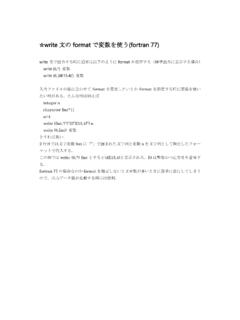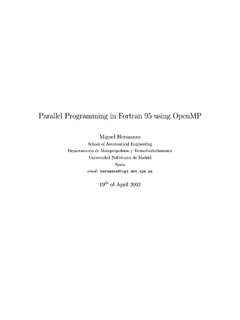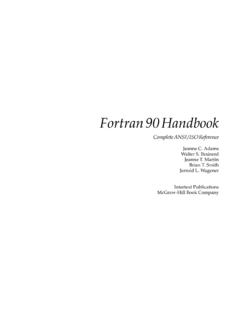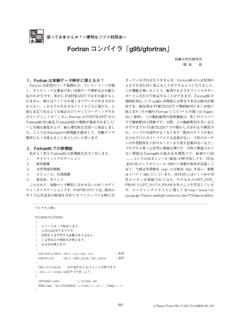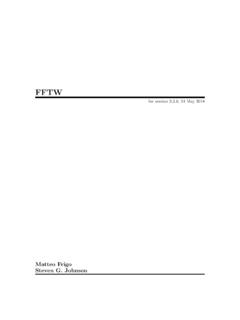Transcription of Fortran Coding Standards and Style
1 Fortran Coding Standards and StyleThe Fortran CompanyVersion 20160112 Copyright 2015-2016, The Fortran CompanyAll rights , with or without modification, is permitted provided that the following conditions are met:1. Redistributions must retain the above copyright notice, this list of conditions, and the following Neither the name of the copyright holder nor the names of its contributors may be used to endorse or promote products derived from this software without specific prior written source file for this document in Open Office format may be downloaded is intended to be an evolving document. Please send comments and suggestions to IntroductionThe following Coding Standards and Style suggestions have been put together with thegoal of making it easier to debug and maintain Fortran the recommendations have arbitrary components, such as the number of spacesto indent in a block.
2 The main thing is to pick a consistent Style for a program, a project, oran organization. Others are recommendations that should definitely be followed whenevercreating new code (e. g., put procedures in a module).Nobody is going to agree to all of these suggestions. A good use of this document mightbe to serve as a basis for a customized Style , obtained by doing some deleting, changing,and Program should consist of a main program, modules, and submodules. Moduleprocedures may be contained in libraries. All procedures should be internal or in amodule or should be small, typically 50 lines or definitions should be in a a function if the procedure returns a single value (including possibly an array orstructure) and the procedure has no side effects.
3 Otherwise, use a Main main program should be used only to call one or more high-level module should be contained in its own source file, except that closely relatedmodules might be put in the same the following two exceptions, the default accessibility of each module should beprivate by including the private statement: A module containing only parameters A collector module containing only use statements that access other modules22 Implicit NoneAll program units should contain implicit none so that all variables, parameters, andfunctions must be Form of a consistent Style from among the many equivalent declaration statements. Thesimplest rule is to put all characteristics of an entity to the left of a double colon (::)and a list of names (possibly with initialization) to the optional keywords to provide readability, for example real(kind=dp), dimension(:, :) :: x_array, the declaration of each entity on a separate line, unless they are closely related, sothat changing the declaration for one should also change the others.
4 Character(len=MAX_CHAR_LEN), dimension(N, N) :: char_A, short names for entities whose use is clear. For example, i and j are acceptable forarray subscripts and x and y are fine as function dummy arguments. Use longer namesfor entities whose purpose is not obvious: distance_to_the_moon. Use different andconsistent schemes for keywords, variables, parameters, procedures, modules, andtypes. The following is just one possible scheme. Some prefer to use lower case , select caseVariablestime, distance_To_The_MoonParametersPI, GOLDEN_RATIOP roceduresDistance, Number_of_PointsModulesPoint_Mod, Reactor_Simulation_ModTypePoint_Type, not use the same name for two different things in the same scope, even whenallowed.
5 For example, do not use print as a variable not use the same name with different uppercase/lowercase spelling, e. g., N and the letters O and l and the digits 0 and 1 in names only when it will be perfectlyclear which character is file name should be the name of the containing entity with the .f90 extension. Forexample, the module Point_Mod should be in the file arrays with meaningful bounds. For example, an array containing the populationof a city for the years 1900 to 2015 can be declared asinteger, dimension(1900:2015) :: population_Of_Tucson 43 Program free-form source the line length to 80 lines in logical places. Indent continued lines double the number of spaces thateach block is indented (see #6 below). meaningful comments blank lines to separate related parts of a blocks a consistent number of spaces (such as 2, 3, or 4).
6 White space freely in statements (e. g., around delimiters).54 Control of only the block, if, do, and select case constructs to control should not be used except for a very rare go to / continue pair (see #3 and ). form of go to (computed, assigned, etc.) should be used, except very rarely (e. g.,exception handling?) a go to statement may branch forward to a labeled a character string for each format. If it is used once, the string may appear in thedata transfer statement (a, ) , The price is $ , priceIf it is used multiple times and does not change, use a character parameter; otherwise, acharacter (len = *), parameter :: PRICE_FORMAT = (a, ) ..print PRICE_FORMAT, The price is $ , price65 not use nonstandard or obsolescent not write tricky code to save a few lines or a few milliseconds.
7 If executionefficiency is important, write code that reflects the algorithm, instrument the code, trysome variations, and comment liberally including the original frequent error checking. For example, test if dummy argument values arereasonable, use status variables for input/output and allocation, and use the inquirestatement prior to opening a file. Always test a status variable after it is used. If theproblem is not clear, try removing the status check and see what the system parameters (named constants) instead of integer, real, or complex literal character dummy arguments and parameters should be declared with length *. functions should be pure and have no side effects (note: what constitutes a sideeffect is controversial).
8 This restriction may be removed temporarily to use debuggingoutput statements, if a graphical debugger is not being array dummy arguments should be assumed shape (:). dummy arguments should have their intent declared. All function dummyarguments should be intent keyword argument calls frequently, including with intrinsic keywords frequently in structure use statement should have an only clause to identify the source of the usedentities. An exception might be for a module with a very large number of used both pointers and allocatables will do the job, use Use the NEWUNIT intrinsic to select am input/output unit number. Never use single-digit unit numbers for standard and error input/output units, use INPUT_UNIT, OUTPUT_UNIT, andERROR_UNIT from the intrinsic module not check for equality or inequality between real or complex values; use closeness logical variables for flags, not integers (and certainly not reals).
9 A context that requires conversion of complex to real or integer or conversion of realto integer, use the intrinsic conversion functions real or at least one digit on each side of the decimal point in real and complex dummy go dummy go of i/o , , , 7standard i/o

